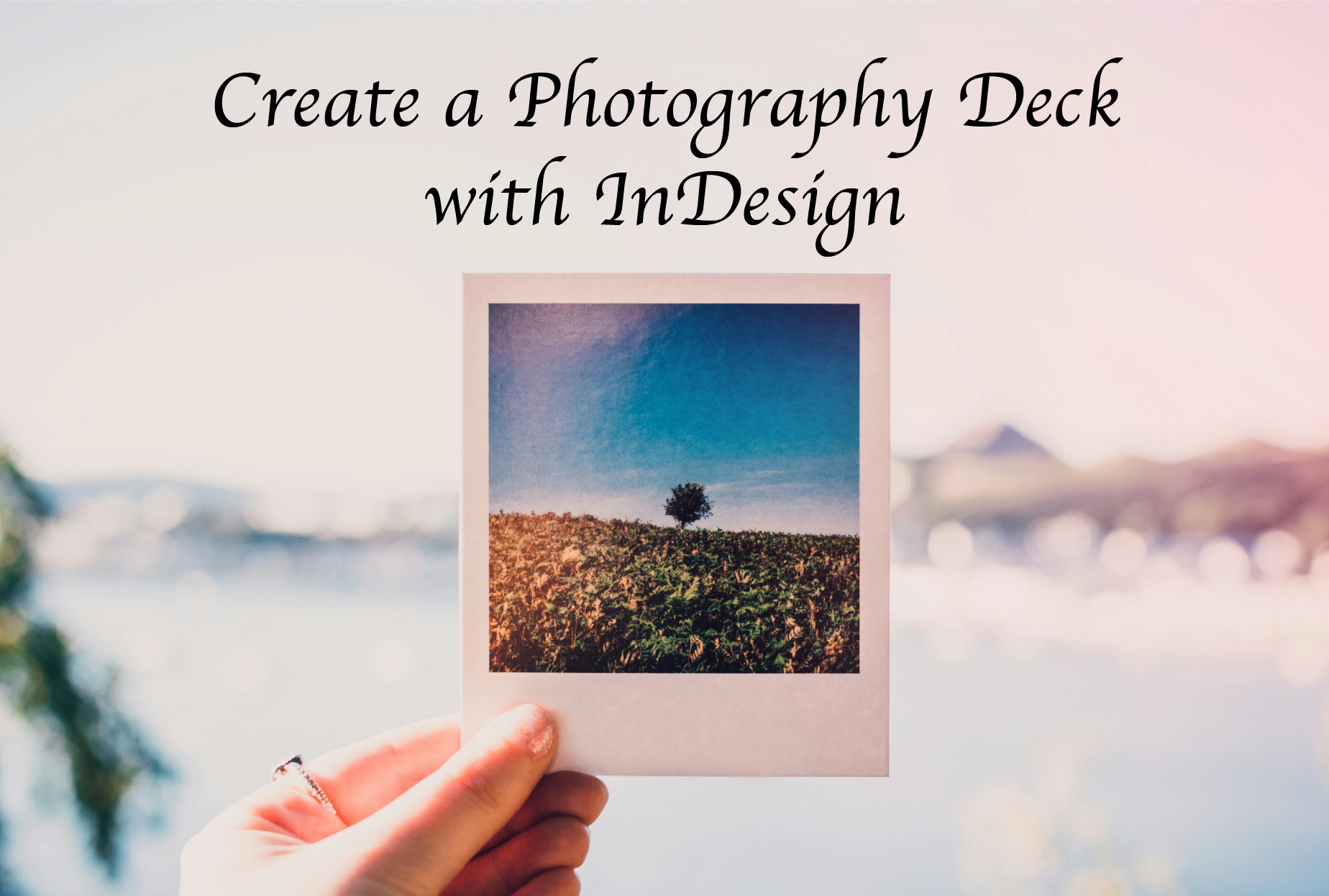
Create a Photography Deck with InDesign
Adobe InDesign is a program suited best for designing and publishing layouts for magazines, newsletters, catalogs, postcards, brochures, decks, and any multi-page document for print or digital delivery. In this tutorial, we will create a photography deck as an introduction to digital publishing. We will cover creating master pages, using guides, threading and placing text, and how to place images and create frames.
Setup a Photography Deck
1. Launch Adobe InDesign.
2. Open a new document. There are a few ways to do this:
- Click the blue button that says New File
- Navigate to File > New > Document
- Press command N on MacOS or control N on Windows.

3. InDesign defaults to using picas as the unit of measure. Change the measurements to inches. We know we want our document to be 10×8 inches. Type in 10 under width and 8 under height. Make sure Landscape is selected for Orientation.
4. Type in 14 for the number of pages. We’ll leave the Start Page # as 1. We’ll leave Facing Pages check marked.
5. Under columns, type in 12. For Gutter, type in 0.1667 in. For Margins, we’ll type in 0.75 in into any of the fields and you’ll notice that all the margins change to match that. If your margins don’t match, be sure the chain button is selected.
6. Click Create.
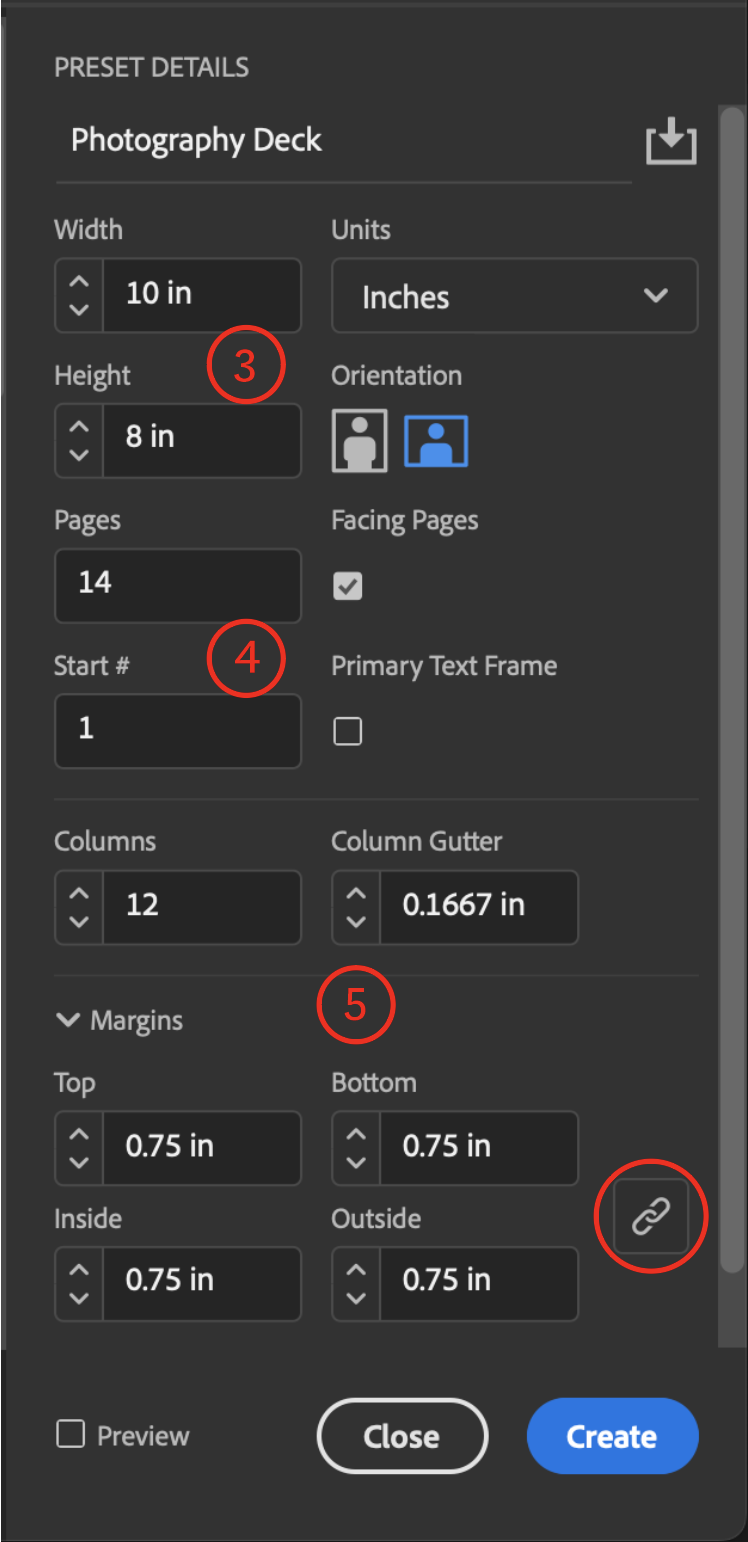
Set Up Parent Pages
Create Guides
Before adding any content to your document, it’s a good idea to set up your parent pages, which serve as backgrounds for your document pages. Any object that you add to a parent page automatically appears on the document pages to which the parent page has been applied. For our parent page, we want to add a footer that shows the page number and the name of our deck.
Tip: You can create multiple parent pages to allow for variation while ensuring consistent design.
1. Click on Pages on the right hand side. If you don’t see it, go to Window > Pages.

2. Double-click on the name A-Parent. The parent spread will now appear in your document window to edit.
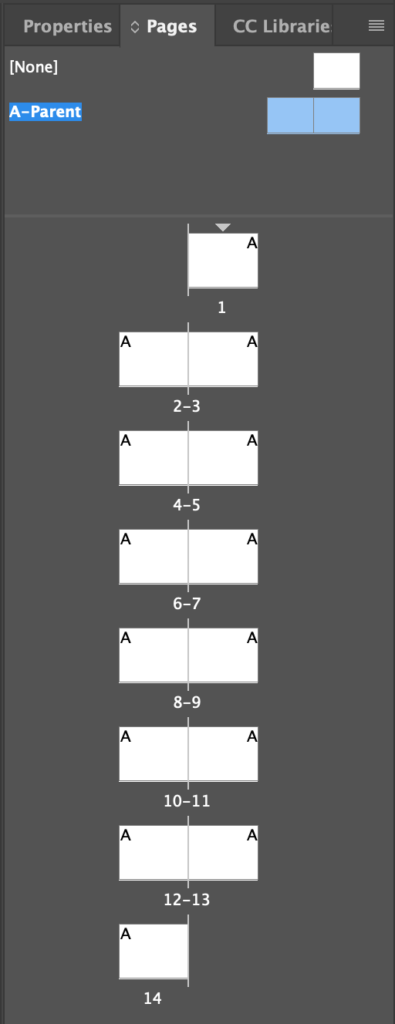
3. Set up guides that show up on the entire spread to help keep a consistent design across all the spreads. Go to Layout > Create Guides…

4. Check mark Preview to display your changes as you make them.
5. Since we’ve already added columns when we created the document, we’ll create 8 Rows with a gutter of 0.1667in and under options, choose Fit Guides to Margins. Click OK.
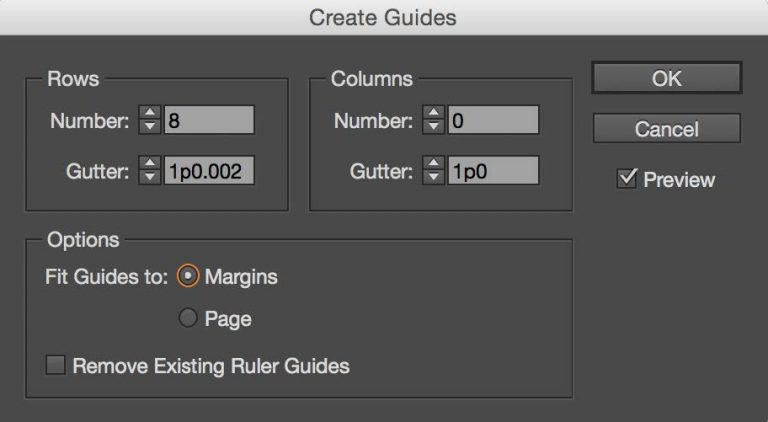
The spread will now look like this:

6. Set the document to use Inches for its Ruler instead of Picas. To do this, right click on the Ruler and select Inches.

7. Make sure your document view is 100%. To do this, select View > Actual Size.
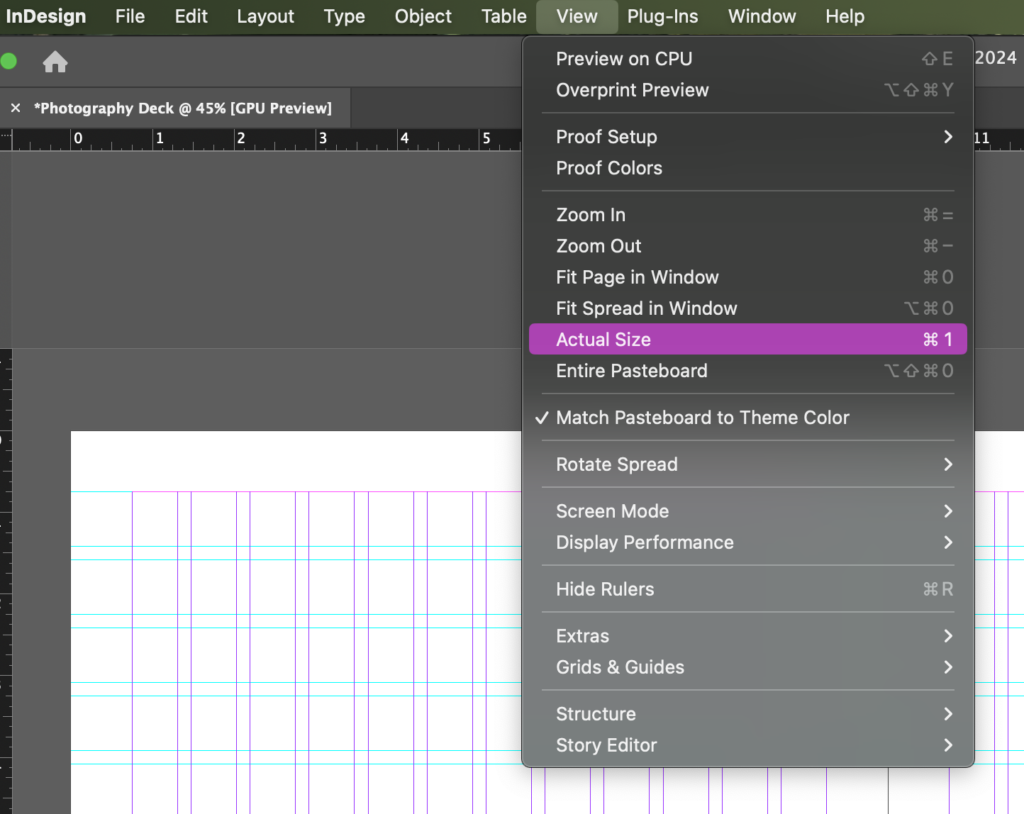
8. Create a guide of where the Page Number and Deck Title will be placed. Click and drag out from any ruler to create a new guide line. Using the ruler on the top of the document, click and drag down to 7.75 inch. A horizontal guide line should appear now at 7.75 inches. Do this for both pages in the Master Spread.
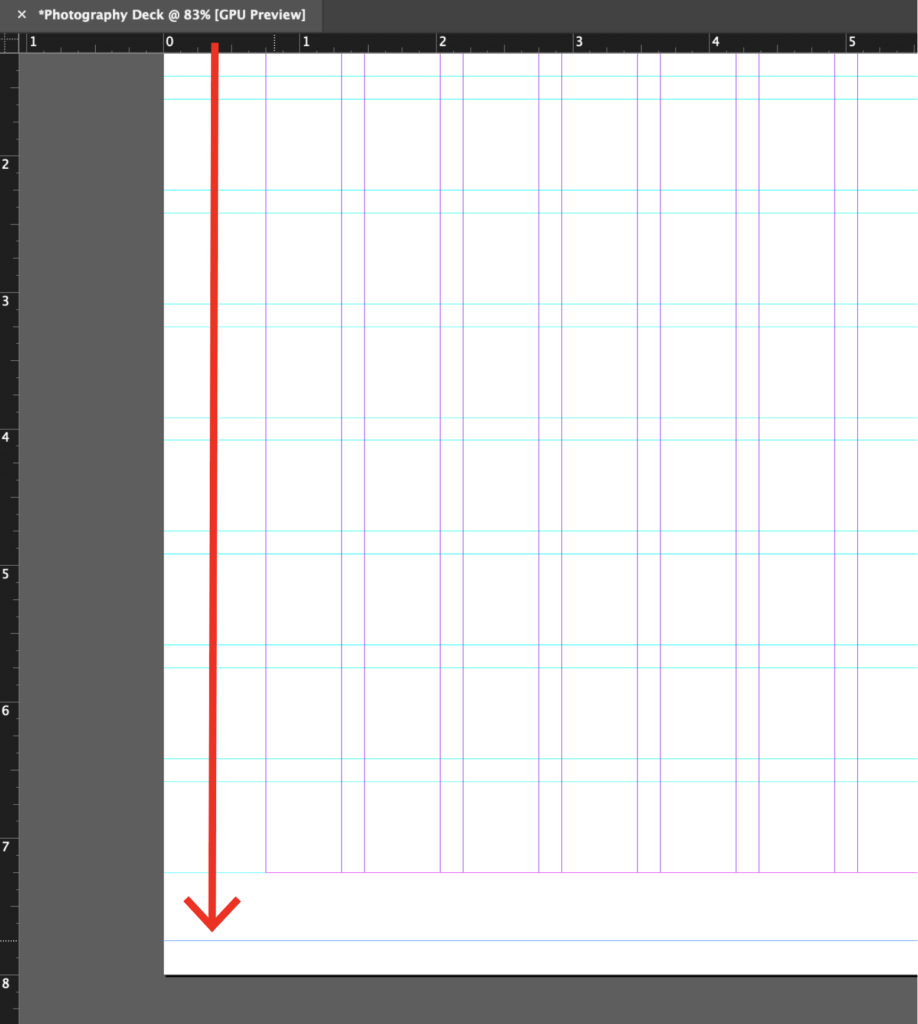
Add Page Numbers
1. I want the page number to appear in the bottom right hand corner and the name of my deck, which will be Veils to appear in the bottom left hand corner. To do this, I’ll select the TEXT TOOL. ![]()
2. Click and drag to create a text box above the guide. Notice, my text box is resting on top of that guide.
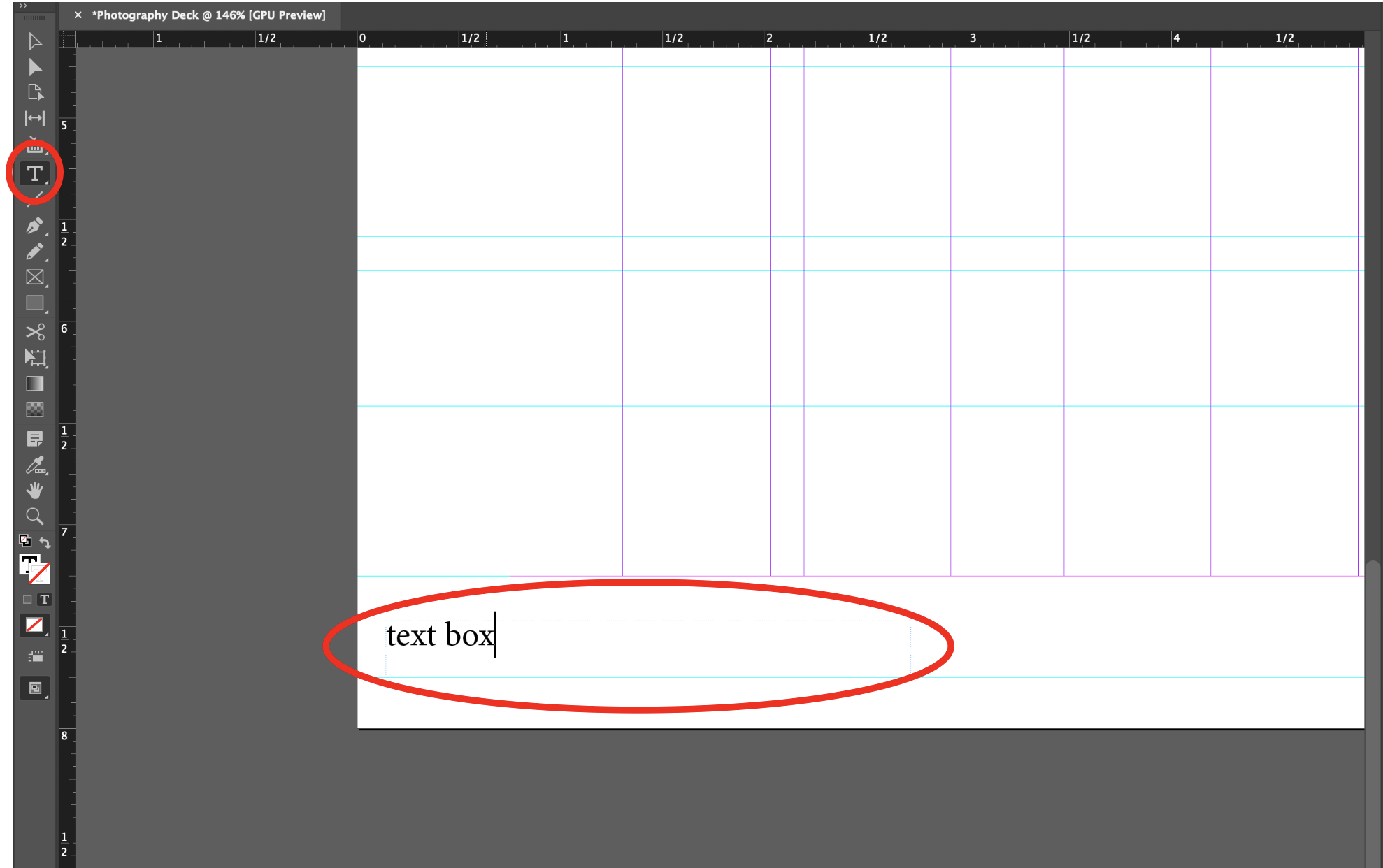
3. Type in “Veils.”
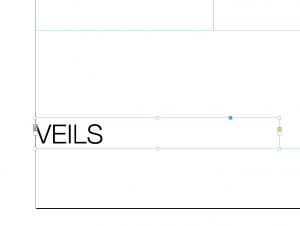
4. While still in the text tool, you can change the font in the Properties Panel. Change it to Helvetica Neue Light, Size 8 pt.
5. Change the alignment to Align Right.
6. Change the font color to White.
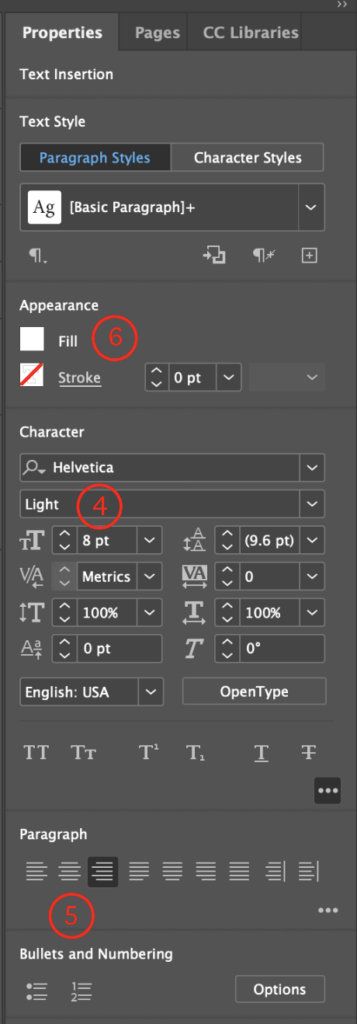
7. I create a guide to the MARGIN LINE and adjusted my text box to go right up to that line. I also created another horizontal guide underneath Veils at the 7.8in line and using the LINE TOOL, ![]() create a line underneath. Click and drag to create your line, while holding SHIFT to keep the line straight.
create a line underneath. Click and drag to create your line, while holding SHIFT to keep the line straight.
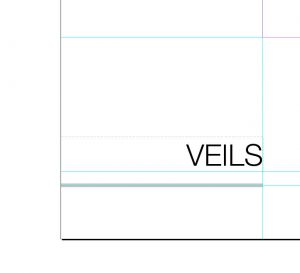
6. In the Properties Panel with the Line selected, set the stroke color to Black and give it a 27% opacity to make it a lighter grey.

7. Create the same guides on the right hand page. Repeat steps 2-6.
- For step 3, add page numbers instead of the title. Create a new text box and with your cursor in the text box, go to Type > Insert Special Character > Markers > Current Page Number. This will place the letter “A” in the text box. Now, any page with the A-Parent applied to it, it will automatically update that letter “A” to the page number that it is.

- For step 5, set the alignment to Align Left.

It should now look like this:

8. Double click on Page 1 to get out of the Parent Page edit mode.
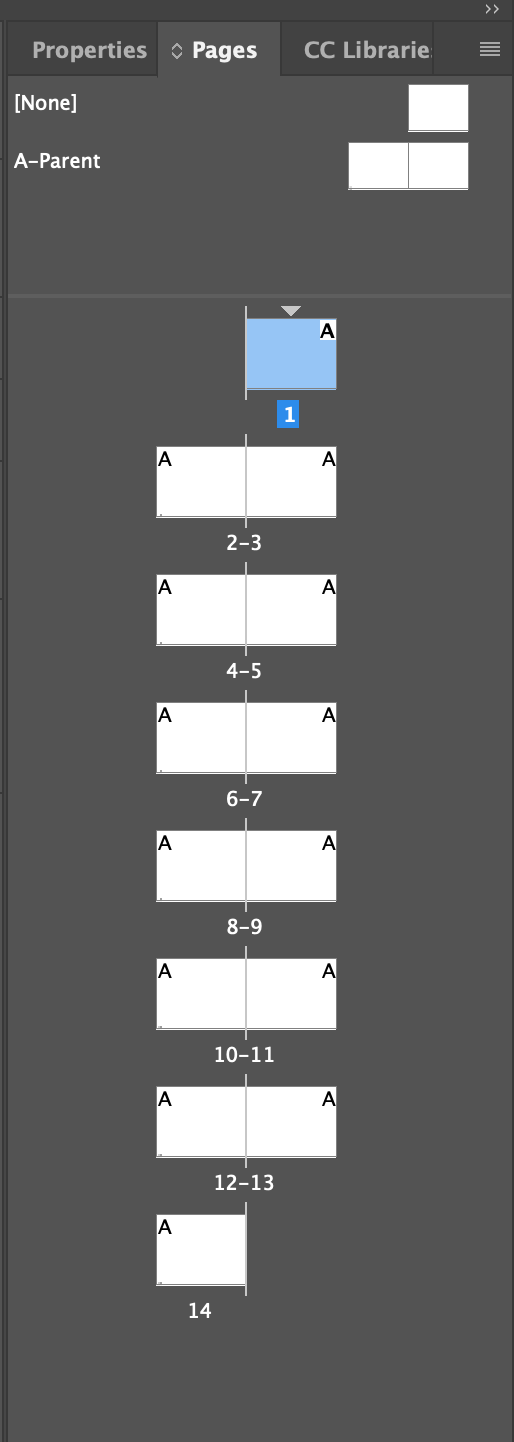
Placing Images into Your Document
For the front of my deck, I want to place image with the title on top of it.
1. Choose FILE > PLACE…
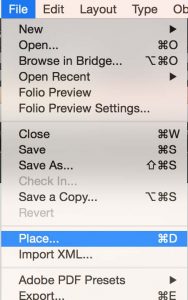
2. Find your image on your computer and click Open.

3. Click anywhere to place your image.
4. Notice that this image overtakes the page. We’ll need to resize the image. Select the SCALE TOOL. ![]()
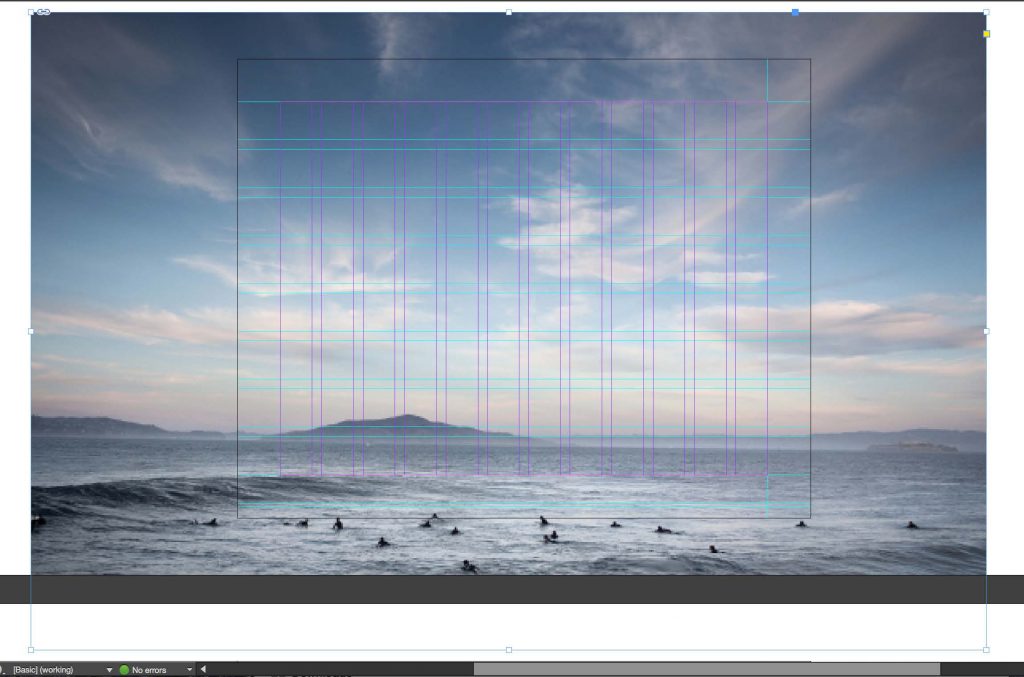
5. With the image selected and while pressing Shift, click and drag in towards the center of the image to decrease it proportionally until it fits to the height of the document size. You’ll notice that it overflows on the sides. This will create a bleed and the image will go all the way to the edge. I’ve also moved the image around to get the part of the image I want to show. To preview how it will look, click on View > Screen Mode > Preview.
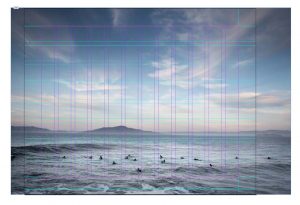
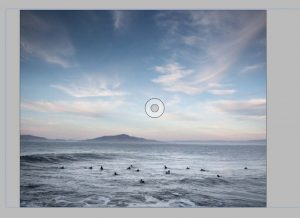
6. Now let’s add the title of the deck on top of the image. Select the TEXT TOOL. ![]()
7. Click and drag to create a text box and type in “VEILS”. Click and drag to create a second text box and type in “The Photographs of Elsa Whitlow”.
8. Using the Properties Panel, change the font and size to how you’d like and arranged it as pictured here:
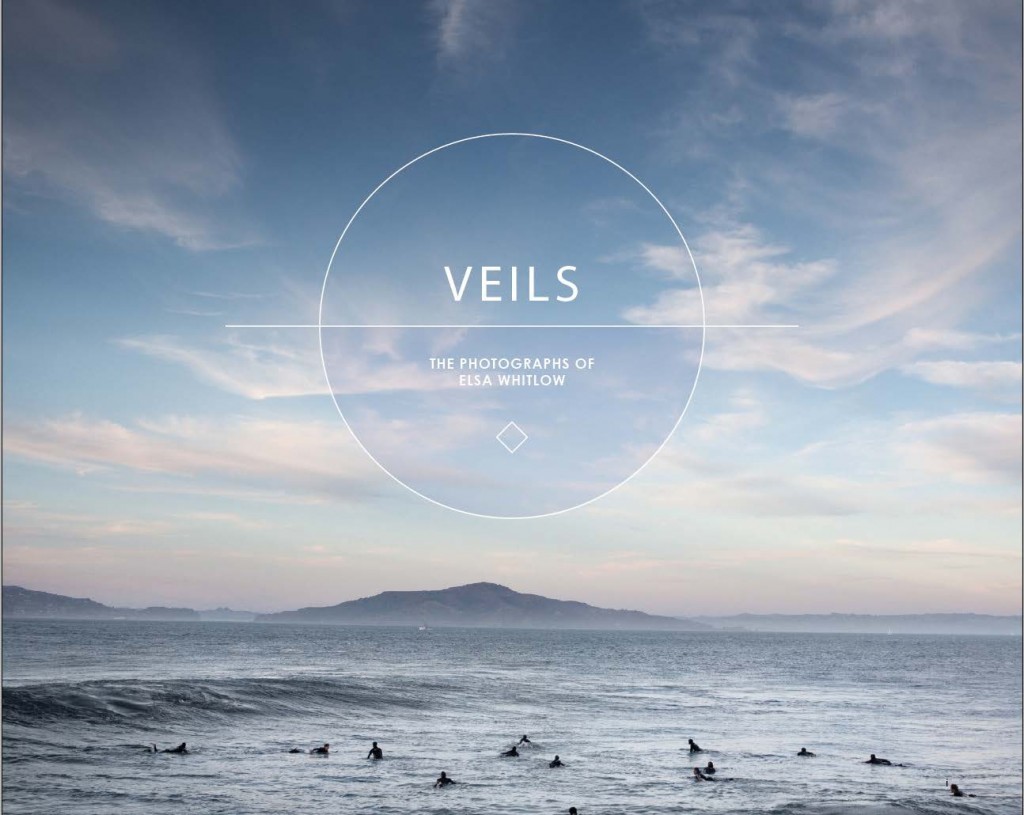
9. Add some shapes to stylize the deck. Use the ELLIPSE TOOL ![]() and LINE TOOL.
and LINE TOOL. ![]() Click and drag to draw the shapes on top of your photo.
Click and drag to draw the shapes on top of your photo.
Tip: Press and hold shift while making the shapes, this will keep the circle proportionate and keep the line straight.
Set Up Character and Paragraph Styles
Paragraph styles let you apply and globally update text formatting to speed up production and create a more consistent overall design. Paragraph styles incorporate all elements of text formatting, including character attributes such as font, size, style, and color, along with paragraph attributes such as indents, alignment, tabs, and hyphenation. In contrast, character styles apply formatting to selected characters such as word or phrase. For instance, in this document, the Headline and bolded text would be a character style and the large chunk of text would be a paragraph style.
Paragraph Style
1. To create a photography deck, start by placing two photographs in your document. Click File > Place… and choose your images.

2. Now that the images are in the spread, add text. Click on the TEXT TOOL. ![]()
3. Click and drag to create a text box. Type the word “FOREWARD” and change your font color to white. This will be the header.
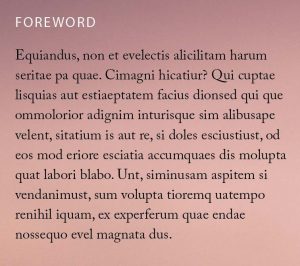
4. InDesign allows you to add in Placeholder text, which places Loreum Ipsum type into your box. This can be helpful when mapping out your document, before placing any text in. While in the text box, right-click and select Fill with Placeholder Text.

4. Now highlight the paragraph of text and format it in the Properties Panel. In this case, I’ve chosen Adobe Caslon Pro Regular, 10 pt font, and 14 pt leading.
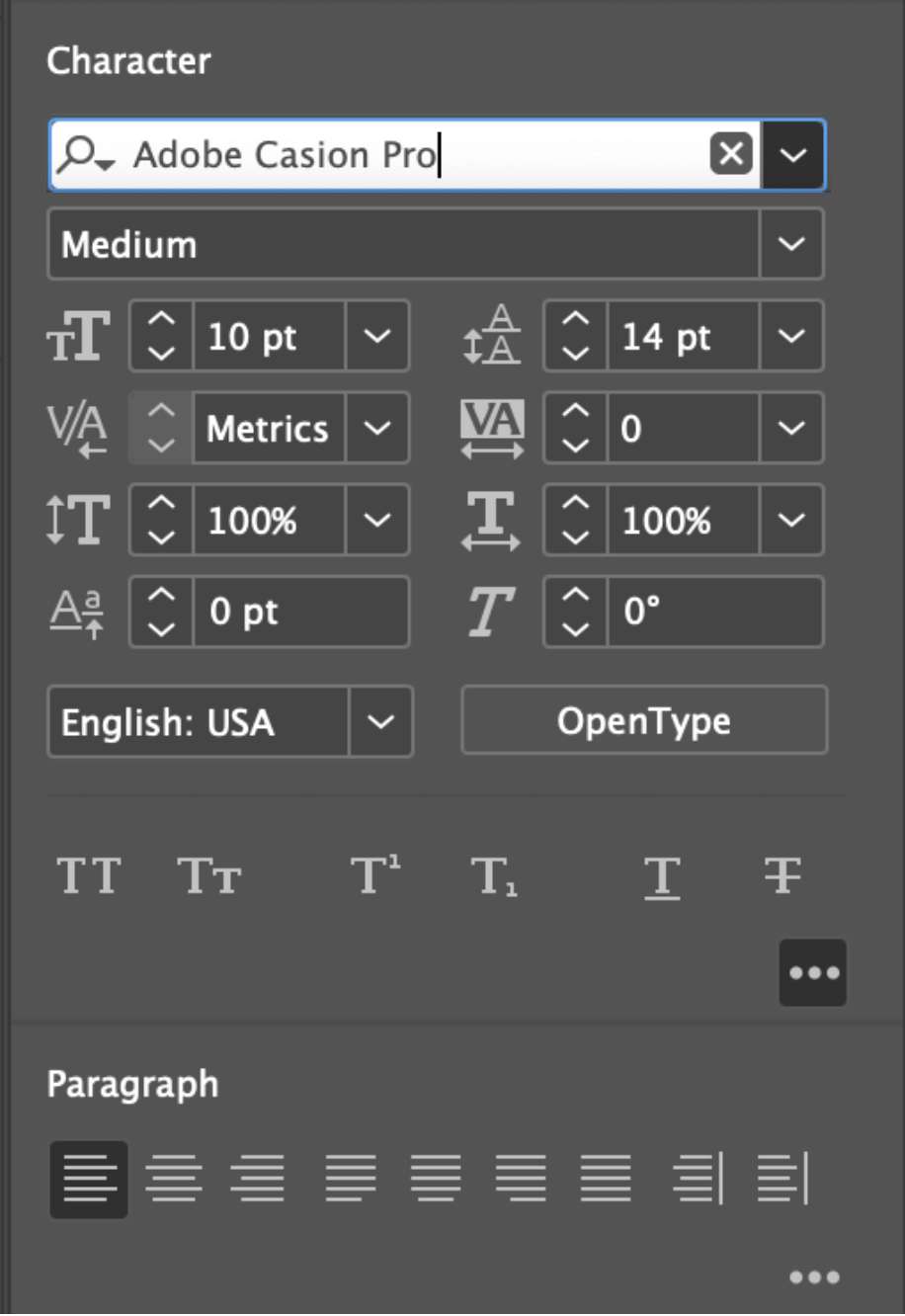
5. With the text still highlighted, click on Paragraph Styles. Navigate to the plus button at the bottom of the menu and click the Create New Style button.
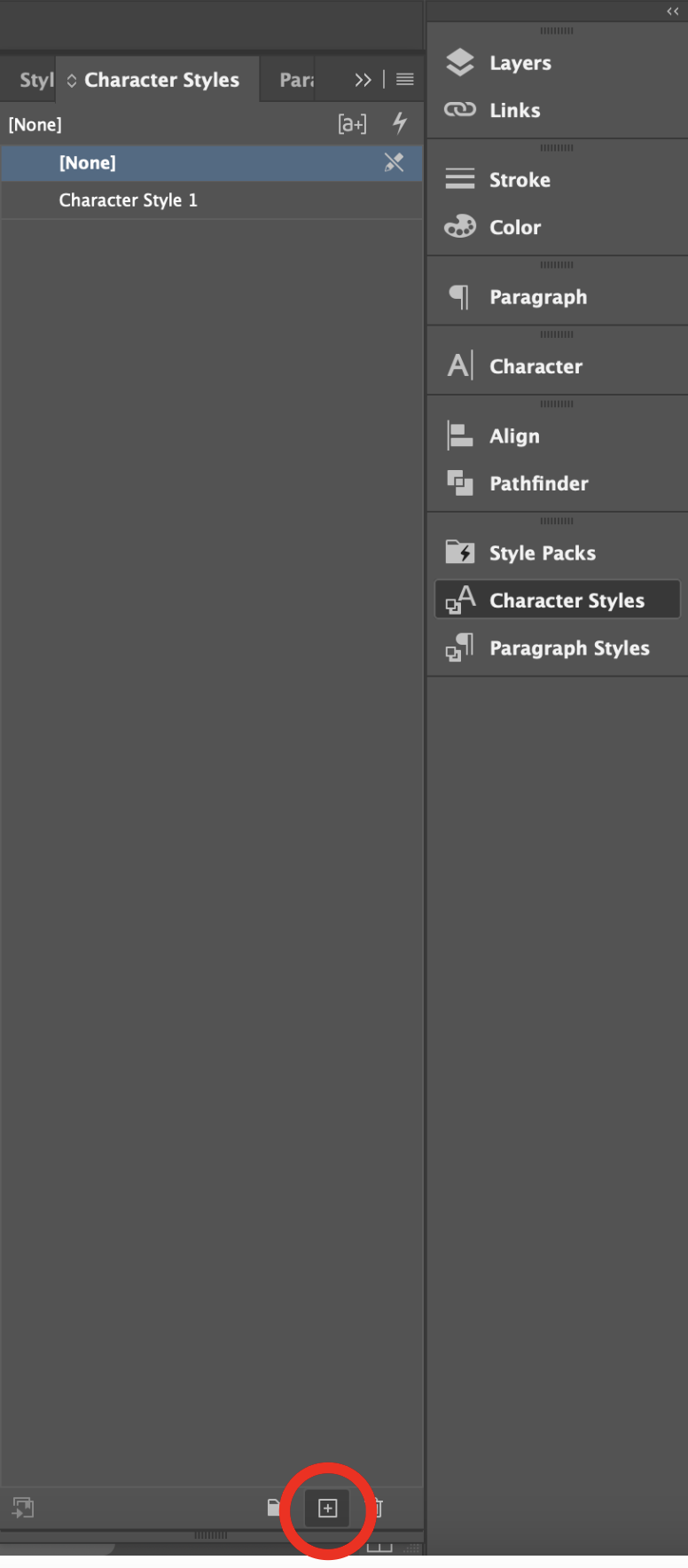
6. In the Properties Panel, navigate to Paragraph Styles. Click on the drop down menu and your new Paragraph Style should be there.
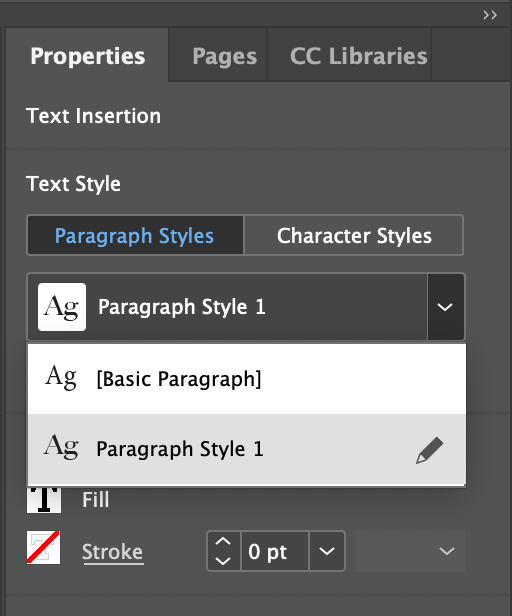
7. Rename your Paragraph Style. Click on the pencil icon and a New Paragraph Style window will open up. Under Style Name, type Body Copy and click OK.

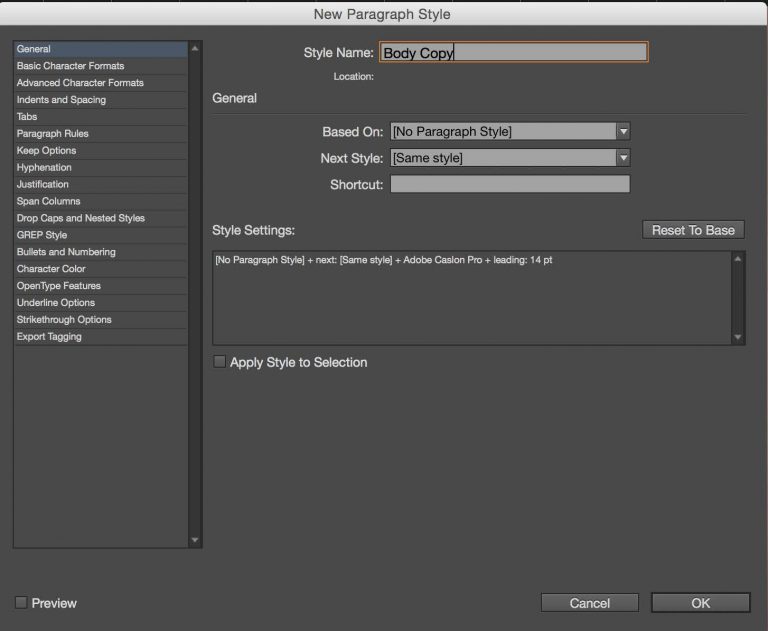
Whenever you need the Body Copy paragraph style, highlight the text you want to change and click on Body Copy. Your text will then change to that paragraph style.
Character Style
1. Now create a Character Style for the White Headings. Highlight the “Foreword” text and click on Character Styles. Navigate to the plus button at the bottom of the menu and click the Create New Style button.
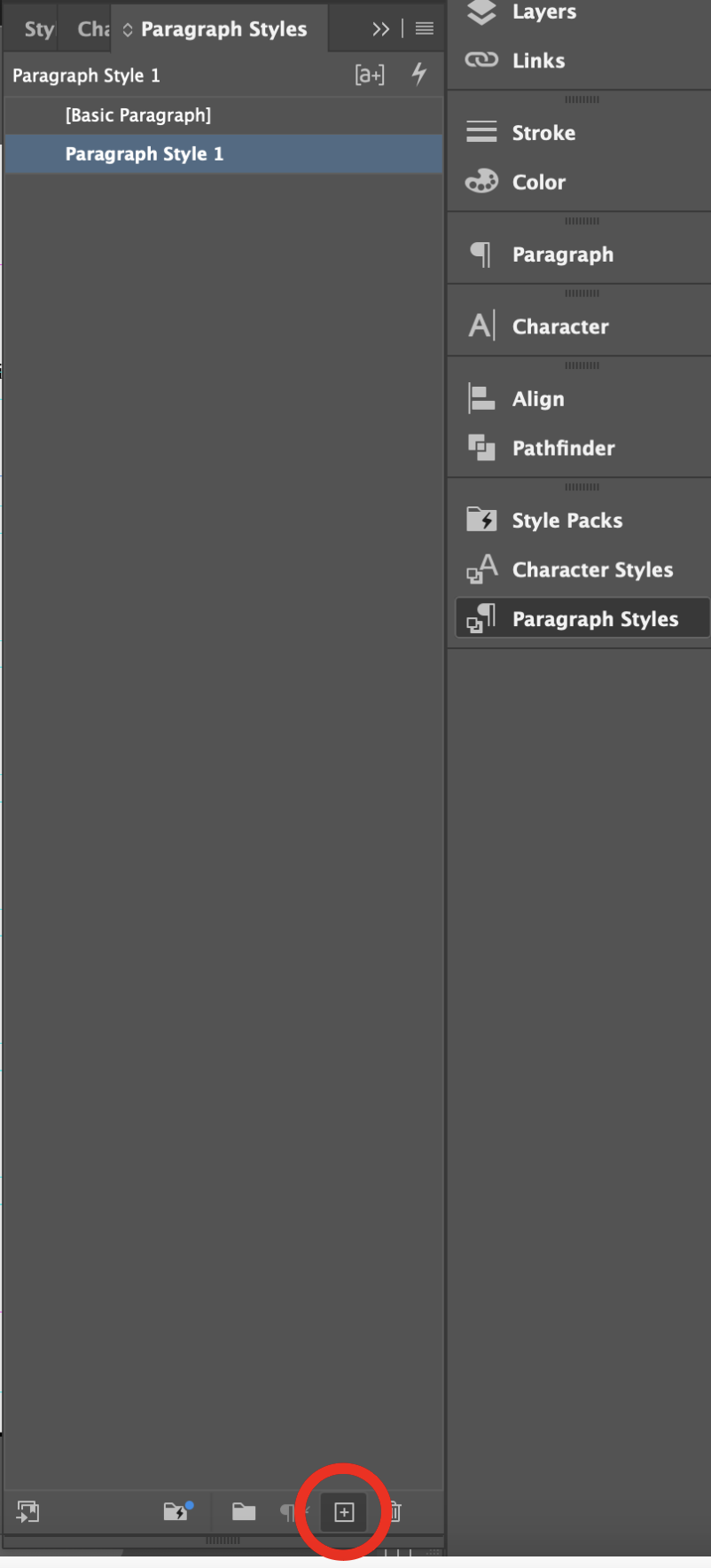
6. In the Properties Panel, navigate to Character Styles. Click on the drop down menu and your new Character Style should be there.
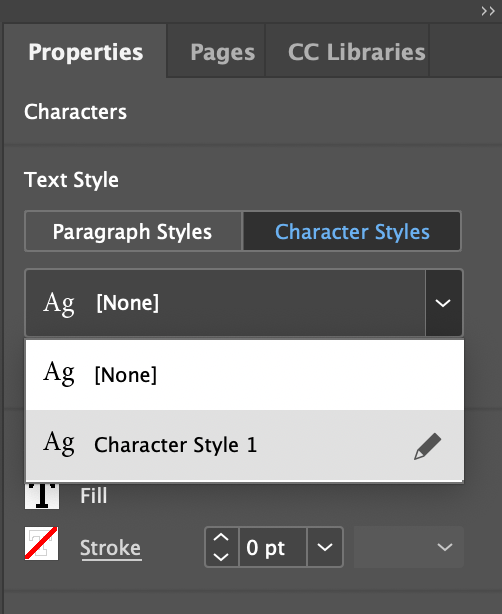
7. Rename your Character Style. Click on the pencil icon and a New Character Style window will open up. Under Style Name, type “White Headings” and click OK.


When creating a document, repeat this step anytime you have a Paragraph or Character style you know that you will want to consistently repeat later in the document. This will be helpful as your document gets longer.
Now you know all the basics to create a photography deck: creating master pages, setting guides/rulers/ bleed/gutter, placing images, and setting paragraph and character styles. Go show off your photos!
Go check out our workshop, Create a Business Card with InDesign, to learn more about projects you can create using InDesign!


